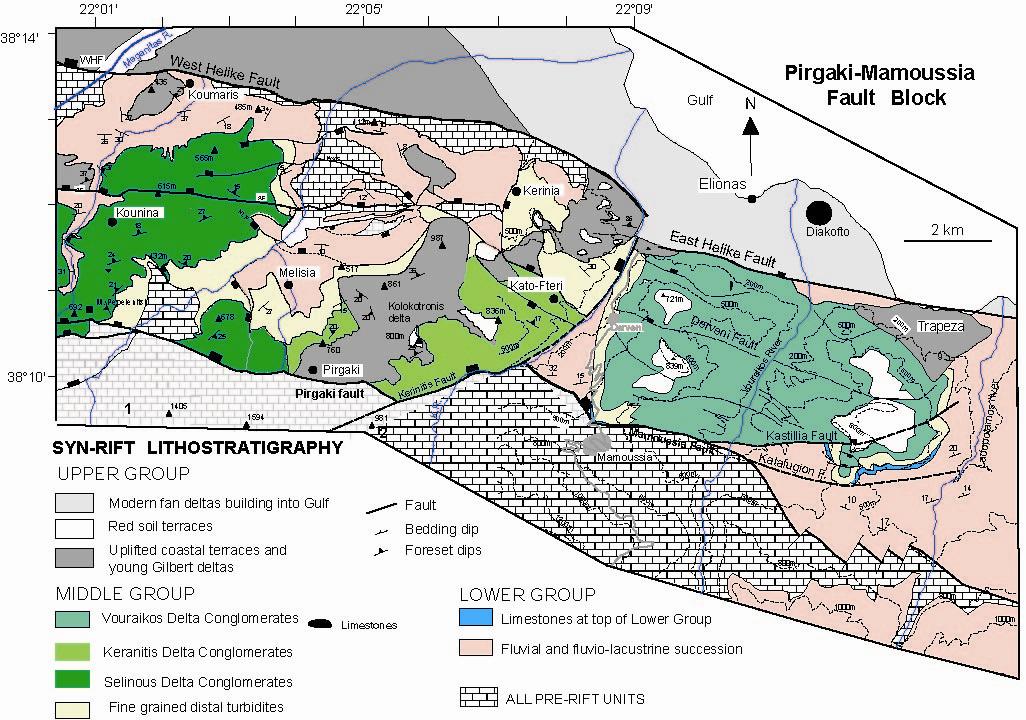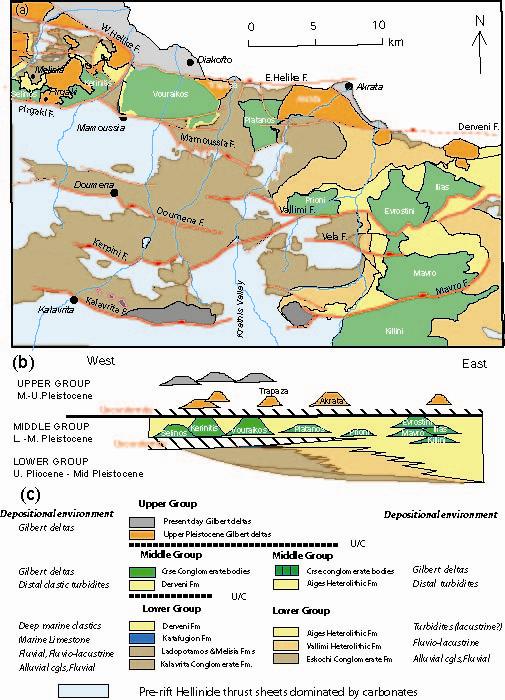![]() Work done at National Oceanographic Center, Southampton (L. McNeil, R. Bell):
Work done at National Oceanographic Center, Southampton (L. McNeil, R. Bell):
![]() Maurice Ewing cruise EW0108 in the Corinth Gulf (2001, B. Taylor, Univ. of Hawai):
Maurice Ewing cruise EW0108 in the Corinth Gulf (2001, B. Taylor, Univ. of Hawai):
![]() Work done at National Oceanographic Center, Southampton (L. McNeil, R. Bell):
Work done at National Oceanographic Center, Southampton (L. McNeil, R. Bell):
![]() Maurice Ewing cruise EW0108 in the Corinth Gulf (2001, B. Taylor, Univ. of Hawai):
Maurice Ewing cruise EW0108 in the Corinth Gulf (2001, B. Taylor, Univ. of Hawai):

With a basal radius of 3.8 km and an arc of 125°, the Early-Middle Pleistocene Kerinitis Gilbert-type delta, covers a surface area of 15 km2 and contains approximately 9 km3 of (preserved) coarse grained sediment. It is very well exposed along a SW-NE 3.8 km long, 600 m high, natural cliff section cut by the Kerinitis river. This seismic-scale cliff represents a true section through the SE side of the delta, which prograded toward the north. Foresets on this river section dip 25° (average) toward N042° (Backert et al, submitted). The point source for the delta was probably inherited from an antecedent drainage system that coincided with the present day Kerinitis river, where it incises into footwall carbonates (Figs 1, 2).

As the base of the delta is not exposed, we assign a minimum delta thickness of 600 m in the Kerinitis river section. The delta base is erosive lying below 200 m altitude in the Kerinitis valley but at 500 m altitude in the Selinous valley to the west. Clasts are dominantly carbonates with minor radiolarites (Upper Triassic to Upper Cretaceous) and some ’flysch’ sandstones (Upper Cretaceous to Eocene), all principally derived from the underlying Pindos thrust sheet (Hellenide orogen, Oligocene-Miocene). The Kerinitis delta is separated from the Vouraikos delta by the Keranitis fault (Fig. 2). To the west, its uppermost west-dipping foresets underlie the east-dipping foresets of the Selinous delta. The red Kolokotronis delta (Upper Group) overlies and masks the Kerinitis delta, with a significant erosional boundary.
The Kerinitis river profile is divided into three zones. To the SW, the 1.5 km long Zone 1, comprises up to 440 m of stacked topsets representing the most proximal part of the delta edifice. Zone 2 is 900 m long and includes the most complex stratal architecture of the delta. In the middle of this zone, a NW-SE trending valley about 1600 m deep, cuts at right angles to the main cliff, providing 3D information. To the NE, Zone 3 (1.4 km long) exposes 600 m of stacked foresets, which pass rapidly north-eastward into bottomset and prodelta facies.


![]() Symmetrical hangingwall delta with fixed point sediment supply.
Symmetrical hangingwall delta with fixed point sediment supply.
The Vouraikos delta (Fig. 1) is the largest of the Lower to Middle Pleistocene deltas with a radius of 4 km, a minimum thickness of 800 m, a surface area of 25 km2 and an estimated volume of 12.6 km3. The delta was deposited in the centre of the Pirgaki-Mamoussia fault block where the estimated throw on the PM fault is over 1500 m. It is incised by its own river that has also incised the pre-rift carbonates in its footwall to create the spectacular Vouraikos gorge through which a small mountain railway runs between Diakofto to Kalavrita. The delta has been uplifted since about 700 ka in the footwall of the Helike Fault, which cut through the front of the delta. Since that time, the Vouraikos river has been building the Diakofto delta out into the present Gulf in the hangingwall of the Helike fault. Displacement on this fault is estimated to be between 3.5 and 6 km (McNeill et al. 2004), implying that it is a far larger fault than older faults to the south. This sequence of events has led to the widely held belief that across the whole rift fault activity migrated northward with time. Due to uplift and incision of three rivers, the Vouraikos delta is exceptionally well exposed in three N-S sections (Fig.4) and two full E-W sections. We can therefore obtain a very good idea of its 3D geometry.


The delta shows a near perfect radial fan of foreset dips (Fig.3a) recording progradation toward the NNW (345°). This symmetry suggest that the Vouraikos delta had a fixed point sediment supply from the footwall throughout its history and that this was the same river that is now incising into it (Type A feeder system of Postma, 1990, 1995).
![]() The delta built into a marine basin.
The delta built into a marine basin.
An algal limestone bed (Fig 3b) forms a step at the gate to the ancient city of Keryneia (located in Figure 2b). Along with another bioclastic limestone found on the delta front, this limestone facies indicates that the delta built into a marine basin (Ford et al., 2007).

![]() The delta infilled a palaeovalley.
The delta infilled a palaeovalley.
The delta is divided into five stratal packages (SP1 to SP5, figs 4 and 5). The lowest part of the delta (SP1) is exposed in the Vouraikos gorge, which cuts through the centre of the delta. The base is not exposed and thus lies below 100 m elevation. To the east and west of the gorge the base of the delta rises gradually to an elevation of 500m (Figs. 2 and 3) Reconstruction of the delta’s internal stratal architecture shows that it gradually infilled a N-S palaeovalley some 7-8 km across and at least 300 m deep. The paleovalley records a major unconformity between the Lower and Middle Groups in the western Gulf. It is estimated that it would take 100-300 ka to erode this valley subaerially. Further west, the Kerinitis delta also infills a similar paleotopography(Backert 2009). The gradual infilling of this palaeovalley can also be appreciated by comparing the N-S cross sections through the centre (deepest valley and showing the most complete delta stratigraphy ) and west of the delta (valley fringe, only youngest stratal units reached here; Fig.4)

![]() Strongly aggrading delta, strong tectonic control.
Strongly aggrading delta, strong tectonic control.
The delta is divided into five stratal units (SP 1 to 5, Figs 2, 4, 5). SP1 records a strongly progradational phase of early delta growth that is associated with aggradational topsets (dominantly fluvial but with rare coastal facies). Note the rollover anticline and tilted blocks at the southern end of the delta in SP1. SP2 is a small delta package found only on the SW side of the delta. It overlies an erosion surface which records a major landward shift in delta construction. SP3 is a strongly aggradation-progradation phase with evidence of intra-delta fault activity. SP4 also records strong progradation with bypass surfaces (although the front of the delta is missing, cut by the Helike fault), but still associated with aggradation. SP4 topsets are sandier and contain many small stacked packages of foresets recording frequent flooding of the delta top. SP5 is a thin unit of shallow marine facies that covered the top of the delta. We interpret this as representing the death of the Mamoussia fault.
The stratal architecture of the Vouraikos delta is dominated by units that are both strongly aggradational and progradational. We interpret this as due to the strong subsidence at the centre of the PM fault system. Nevertheless, the same pattern of delta construction can be detected with early strong progradation, giving way to strong aggradation. These can be interpreted as representing early and main fault growth phases.

In a 600km2 area south of Aegion to Xylocastro (Fig.1) the onshore syn-rift stratigraphy is divided into three informal groups (Rohais et al. 2007; Ford et al. 2007; Backert et al. in revision).

Figure 1. General geology of the central south coast, showing syn rift sediments and major Lower to Middle Pleistocene Gilbert deltas (adapted from Ghisetti et Vezzani 2006; Rohais et al. 2007; Ford et al. 2007; Backert et al. in revision). The areas covered by various authors are indicated.

Figure 2. Synthetic map (unpublished) of structure and Plio-Pleistocene syn-rift stratigraphy of the Corinth rift adapted from Rohais et al. (2007), Ford et al. (2007), Ghisetti & Vezzani (2005), Backert et al. (in rev) and unpublished field data (Ford 2009). (b) EW section of lateral correlations.(c) Legend.
Lower Group: 1.3 km alluvial-fluvial sediments in W, 400 m fluvio-lacustrine sediments in NW (south of Aegion), 1.8 km fluvio-lacustrine sediments E of Akrata. All sourced from W –WSW. estimated age :Pliocene-early Pleistocene
Middle Group: Gilbert-type fan deltas, Sourced from S, prograde mainly N, locally NE (Prioni), and NW (Ilias). Up to 1000 m thick. Rift narrows in W (deltas restricted to north of the PM fault), but remains wide in E. Estimated age: early-Middle Pleistocene.
Upper Group: Local onshore deposits of small Gilbert deltas, fluvial terraces, red soil terraces, slope deposits and marine terraces on the range front. All were deposited during uplift of the south coast. Deposition offshore (Bell et al. 2008). Estimated age: Middle to Late Pleistocene
Contact: Mary Ford
On-shore
Off-shore
The AIG10 borehole on the Aigion fault is a 1000m deep hole intersecting the Aigion fault, on the southern shore of the Corinth Rift. The fault is intersected at 760m.

AIG10 cross-section (Naville et al., Rettenmayer et al., 2004)
The borehole was drilled in 2002 and instrumented with a permanent monitoring system installed from September 2003 to February 2005. Only a small portion of the scheduled system has been installed: the fault could not be sealed, and only pore pressure data could be recorded under a surface plug, together with a surface hydrophone.
The whole system has been installed in 2007, but above the fault.
The data available are:
![]() electrical image log (UBI) from 2002
electrical image log (UBI) from 2002
![]() pore pressure from the first phase of the instrumentation, from 2003 to 2005.
pore pressure from the first phase of the instrumentation, from 2003 to 2005.
Vertical tectonic motion deduced from the modelling of marine terraces by Pantosti et al., 2002

Geometry of main active faults as defined by the CRL working group